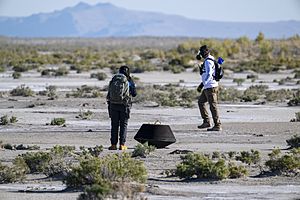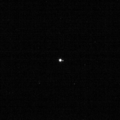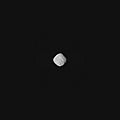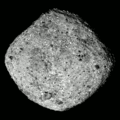OSIRIS-REx facts for kids
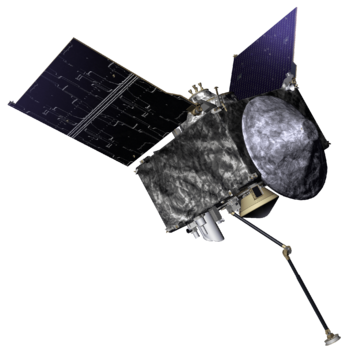
Artist's rendering of the OSIRIS-REx spacecraft
|
|
| Names | OSIRIS-REx New Frontiers 3 OSIRIS-APEX |
|---|---|
| Mission type | Asteroid sample return |
| Operator | NASA / Lockheed Martin |
| Mission duration | 7 years (planned) 889 days at asteroid (actual) 9 years, 3 months, 13 days (elapsed) |
| Spacecraft properties | |
| Manufacturer | Lockheed Martin |
| Launch mass | 2,110 kg (4,650 lb) |
| Dry mass | 880 kg (1,940 lb) |
| Dimensions | 2.44 × 2.44 × 3.15 m (8 ft 0 in × 8 ft 0 in × 10 ft 4 in) |
| Power | 1226 to 3000 watts |
| Start of mission | |
| Launch date | 8 September 2016, 23:05 UTC |
| Rocket | Atlas V 411 (AV-067) |
| Launch site | Cape Canaveral SLC-41 |
| Contractor | United Launch Alliance (ULA) |
| End of mission | |
| Disposal | Sample Return Capsule: Recovered |
| Landing date | Sample Return Capsule: 24 September 2023, 14:52 UTC |
| Landing site | Utah Test and Training Range |
| Orbital parameters | |
| Reference system | Bennu-centric |
| Altitude | 0.68–2.1 km (0.42–1.30 mi) |
| Period | 22–62 hours |
| Flyby of Earth | |
| Closest approach | 22 September 2017 |
| Distance | 17,237 km (10,711 mi) |
| Bennu orbiter | |
| Orbital insertion | 31 December 2018 (Rendezvous: 3 December 2018) |
| Orbital departure | 10 May 2021 |
| Sample mass | Between 60 g (2.1 oz) and 2,000 g (71 oz) |
| Bennu lander | |
| Landing date | 20 October 2020, 22:13 UTC |
| Landing site | "Nightingale" |
| Flyby of Bennu | |
| Closest approach | 7 April 2021 |
| Distance | 3.5 km (2.2 mi) |
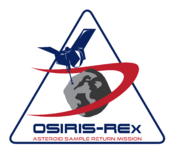 OSIRIS-REx mission logo New Frontiers program
|
|
OSIRIS-REx is a NASA space mission. Its full name is Origins, Spectral Interpretation, Resource Identification, Security, Regolith Explorer. The main goal of OSIRIS-REx was to visit an asteroid called 101955 Bennu and collect a sample from its surface. Bennu is a near-Earth object, meaning it passes close to Earth.
Scientists hope that studying the material from Bennu will help them learn more about how our Solar System formed. They also want to understand the early stages of planet formation. The mission aims to find out where organic compounds, which are important for life, came from on Earth.
After its main mission, the OSIRIS-REx spacecraft will continue its journey as OSIRIS-APEX. It will travel to another asteroid named 99942 Apophis. The spacecraft is expected to reach Apophis in April 2029. This will happen around the same time Apophis is predicted to have a close encounter with Earth.
Scientists chose Bennu as the target because it's like a "time capsule" from when the Solar System was born. Bennu has a very dark surface. It is a type of asteroid called a carbonaceous asteroid. These asteroids are considered very old and haven't changed much since they formed. Bennu was picked because it likely has untouched carbon-rich material. Carbon is a key element in organic compounds, which are needed for life. It also represents matter from before Earth was formed. Scientists have found organic molecules, like amino acids, in meteorites and comet samples before. This shows that some ingredients for life can naturally form in space.
Contents
The OSIRIS-REx Mission
The name OSIRIS comes from the ancient Egyptian god Osiris. He was known as the lord of the underworld.
NASA's Goddard Space Flight Center managed the mission. They also handled the engineering and guided the spacecraft. The science team included experts from many countries. These included the United States, Canada, France, Germany, United Kingdom, and Italy.
Journey to Asteroid Bennu
OSIRIS-REx launched into space on September 8, 2016. It traveled for about two years to reach Bennu. In December 2018, the spacecraft arrived at the asteroid. It then spent 505 days mapping Bennu's surface. It did this from about 5 kilometers (3 miles) away.
The mission team used these maps to pick the best spot to collect a sample. After choosing the site, the spacecraft got very close to the asteroid. It did not land, but extended a robotic arm to grab the sample.
Bringing the Sample Home
The spacecraft collected more than 60 grams (about 2 ounces) of material. This sample was then put into a special capsule. The capsule weighed about 46 kilograms (101 pounds). It was similar to the one used by the Stardust spacecraft to return comet samples.
The journey back to Earth was shorter. The capsule landed safely by parachute in the Utah Test and Training Range. This happened on September 24, 2023. From there, it was taken to the Johnson Space Center. Scientists will study the sample in a special research facility.
Images for kids
-
Asteroid Bennu, imaged by the OSIRIS-REx probe, 3 December 2018
-
Animation of OSIRIS-REx's trajectory from 9 September 2016 OSIRIS-REx · 101955 Bennu · Earth
-
Animation of OSIRIS-REx's trajectory around 101955 Bennu from 25 December 2018 OSIRIS-REx · 101955 Bennu
See also
 In Spanish: OSIRIS-REx para niños
In Spanish: OSIRIS-REx para niños


